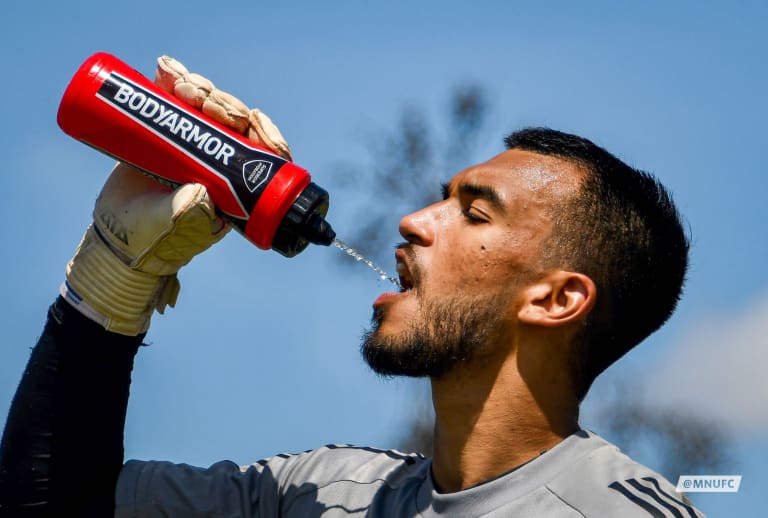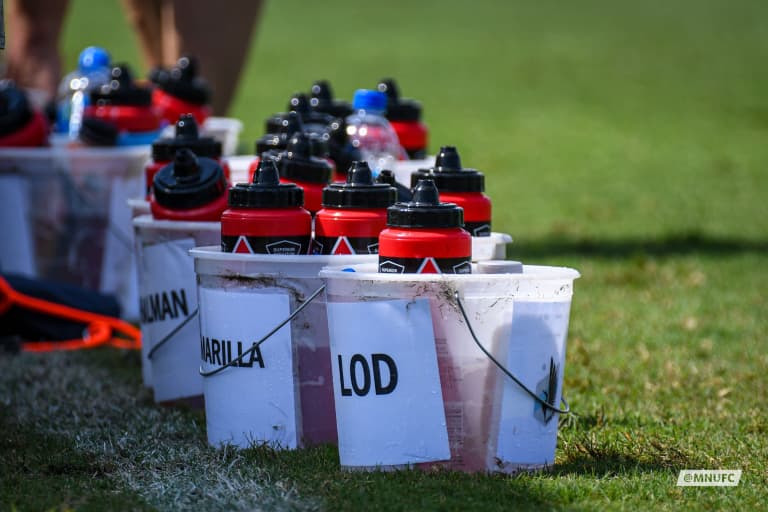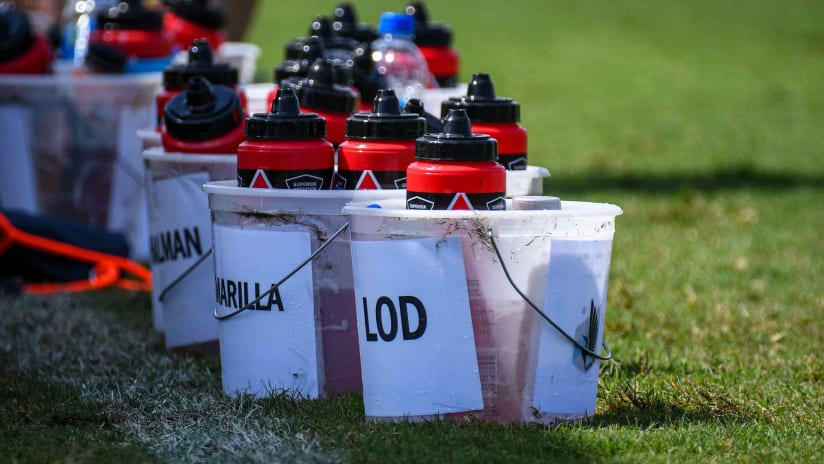It’s not at all unusual for athletes to sweat during a game, but if you’ve tuned into the MLS Is Back Tournament, you might have found yourself wondering if it’s normal for them to sweat quite that much. Some look like they’ve just taken a dip in the Swan and Dolphin Resort pool, or more like they’re playing in a deluge at Portland’s Providence Park than in sunny Florida.
And so, like many a person finding their shirt more than a little damp before a big job interview, you may find yourself asking, “Is this normal?”
“It’s very normal,” said Minnesota United Team Dietitian Angela Bruzina. Her job focuses on player nutrition and — more recently — hydration. “On average, players will lose anywhere between two pounds to six or seven pounds of water from a training session. That’s quite a lot. For every two pounds of sweat that they lose, that’s almost a full liter of water.”
A full liter of water is just a bit more than the 32-ounce Nalgene you drink during the work day. The hot, humid climate in Orlando pushes the numbers towards the high side of that scale. It also means Bruzina hammers home the importance of the hydration aspect of recovery, since the current conditions don’t rule out the extremities that root from dehydration like heat exhaustion and heat stroke.
“Just a two percent decrease in their weight can cause performance deficit,” said Bruzina. “So they’re performing not at tip-top shape.”
“An analogy I heard once is thinking about the difference between a fresh steak and beef jerky,” said Head Athletic Trainer Stacey Hardin. “If you think about a muscle the same way, if it’s dehydrated, you know how much easier it is to tear beef jerky than it is to tear fresh steak. So it really helps not only from the performance standpoint, but the muscles’ ability to function when it’s well-hydrated, and then the body as a whole.”
In Florida, Bruzina has mirrored the schedule she keeps in Blaine, ending breakfast an hour before training. The buffet is a well-balanced spread focused on easily digestible carbohydrates — waffles, pancakes, oatmeal and potatoes. And lots of fruit.
Bruzina weighs every player before and after training, in dry clothes. She’s tracking players’ weight and calculating the amount of weight lost and, in turn, fluid needed to rehydrate. For every pound lost, a player has to replenish with between 16 and 24 ounces of fluid — basically a biggish bottle of water from the gas station.
“It’s all about education at the scale. So two pounds down, that’s two bottles of fluid. And I provide them with water and other products they can choose from,” said Bruzina. “That’s at least two bottles before you go to lunch.”
Lunch features options both nutritious and water dense for rehydration help. From a solids standpoint, that means mixed fruit salads with watermelon, cantaloupe, honeydew and pineapple, in addition to the whole fruit offered. The liquid line up in the lunch room showcases smoothies, tea, iced tea, juice, milk and flavored electrolyte packets to mix with water.
“Our body doesn’t do a wonderful job of absorbing plain water, because there’s no electrolytes in it like salt or potassium,” explained Bruzina. “Our bodies love to take water in with minerals. When there’s salt and potassium in the fluid that helps absorb more of the water in those foods and fluids.”

If a player is consistently losing five or six pounds every day, Bruzina will set a goal for the next week to try and help get that number down. The first option is for the player to drink more during the training session itself, which will help them lose less through sweat. For the players that drink solely water while they’re training, Bruzina explains the importance of making up for the salt lost during the session and ways they can replenish. Every player has a different preference, and some players aren’t fans of the extra fluid sloshing around in their stomach during the session.
The second option is a little more … extreme.
“They don’t enjoy it, but they do it,” said Bruzina. “We have a very rapid hydrating product that has 1800 milligrams of sodium in it.” That’s about nine orders of fries from McDonald’s worth. This isn’t recommended for the recreational athlete and high sodium doses should only be done under the care of a medical professional. “Some of our guys will use that before training, because with salt, comes water. If they ingest a fair amount of salt prior to training, they’re going to retain the majority of the water they drink during the training session, so in theory, they sweat less. It doesn’t taste great. But it helps them a lot.”
It's Florida in August. Everyone is sweating. But it’s Bruzina’s job to make sure that what the players sweat out gets put back in so they can keep performing at a high level. So long as she does her job, then yeah, it’s very normal.






